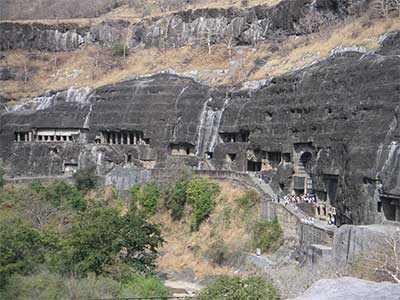Daily-current-affairs
/
30 Oct 2020
Ajanta Caves : Daily Current Affairs

Ajanta Caves
Why in NEWS ?
- Ajanta Caves deposit to be preserved for eternity.
About
- A team of members from the data preservation facility - Arctic World Archive(AWA)
has initiated the deposit of India’s ancient historical site --Ajanta Caves --which will
be digitised and restored for eternity.
- Ajanta Caves is a pride of India, it is one of those few heritage sites that open an
entire gateway to culture. The historic event of preserving the deposits was carried
out at Svalbard, a remote island in Norway.
- Experts across the globe believe that the paintings of Ajanta have a powerful impact
on human consciousness if seen through the right eyes in its original glory. This
deposit marks the beginning of a series of deposits of digitised and restored
paintings of Ajanta Caves. One of the greatest arts of Ajanta, photographed by Benoy
Behl, is in this token deposit, along with papers and quotes on Ajanta Caves and
some more restored work.
- In order to support the initiative, AWA received messages from the greatest
industrialists, bureaucrats and political leaders of India.
- The ancient art is now getting preserved for all generations to come, for their
inspiration, peep into history and pleasure
- Art and culture which kept our inner faculties to develop will be on the wane, but no
one can develop technology unless human facilities work to optimum, getting
creativity to fore. This art will help us all as true fully grown human.
Arctic World Archive (AWA)
- Arctic World Archive is a unique archive deep inside a decommissioned coal mine in
the remote arctic island of Svalbard in Norway, where items of world memory are
stored to last nearly 1,000 years.
- It is managed by Norway-based PIQL. In a ceremony conducted at the site, the
process of preservation of Ajanta Caves for eternity was initiated.
- Sapio Analytics’ Heritage Restoration division, headquartered in Palo Alto, California,
reconstructs ancient heritage and culture using artificially intelligent technologies.
- It has also partnered with legendary art historians like Benoy Behl to help in such
restoration. Ajanta Caves’ restoration and preservation is part of its grander efforts
to create an indestructible world that replicates the original glory and opens a
gateway to cultures across countries.
- The Arctic World Archive is a growing digital repository of world memory located at
the remote island of Svalbard in the Arctic Ocean. Piql’s innovative approach to
archiving repurposes photosensitive film to be a digital medium.
- Data is stored using high density QR codes with all information needed to recover
the information also stored on the film, making it self-contained and future-proof.
- This tried and tested technology can keep data alive for hundreds of years, without
the need for migration.
- The ancient art is now getting preserved for all generations to come, for their
inspiration, peep into history and pleasure
- Ajanta Caves is the first deposit of a UNESCO world heritage site into the Arctic
World Archive.
- A.I. and Deep Learning are used to restore the broken images in the said paintings. In
order to restore these images, deep learning is applied along with knowledge from
the leading art historians of the world, to create the right labels that are being fed
into the deep learning models. Dataset training is done through manual restoration
of some paintings
Ajanta Caves
- Ajanta is a series of rock-cut caves in the Sahyadri ranges (Western Ghats) on
Waghora river near Aurangabad in Maharashtra.
- Ajanta caves are a series of 30 Buddhist caves located in Aurangabad district,
Maharashtra.
- Out of the 30 excavated caves, five (cave no. 9, 10, 19, 26, and 29) are chaitya grihas
(prayer halls) and the rest(25) are viharas (monasteries).
- This site is declared a World Heritage Site by UNESCO in 1983.
- It encompasses both Theravada (Hinayana) and Mahayana Buddhist traditions.
- The Ajanta caves preserve some of the best masterpieces of Buddhist art in India.
- Recognised around the world for its significance both in art and culture, this is a very
worthy addition to this growing repository of global memory.
Timeline
- The caves were developed in the period between 200 B.C. to 650 A.D.
- The Ajanta caves were inscribed by the Buddhist monks, under the patronage of
the Vakataka kings – Harishena being a prominent one.
- Reference of the Ajanta caves can be found in the travel accounts of Chinese
Buddhist travellers Fa Hien (during the reign of Chandragupta II; 380- 415 CE)
and Hieun Tsang (during the reign of emperor Harshavardhana; 606 - 647 CE).
Painting
- Ajanta Paintings are finest surviving examples of ancient Indian art.
- According to UNESCO, these are masterpieces of Buddhist religious art that
influenced Indian Art.
- These masterpieces at Ajanta were executed more or less in two phases.
- The outlines of the paintings were done in red colour. One of the striking features is
the absence of blue colour in the paintings.
- The paintings are generally themed around Buddhism – the life of Buddha and Jataka
stories.







